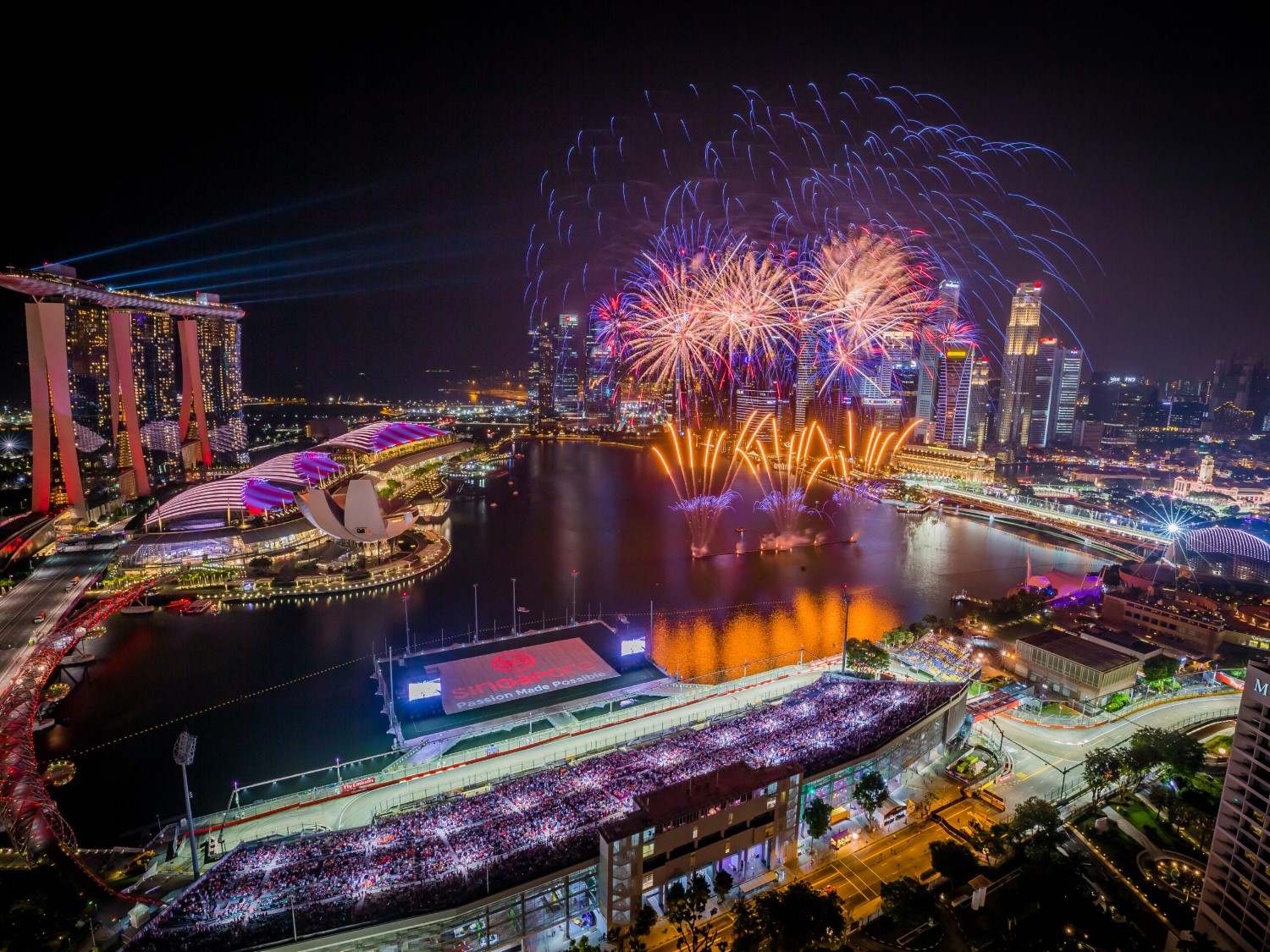F1: 2023 Singapore GP Preview
Formula One racing makes its return to Singapore this coming weekend for the 14th time at the floodlit Marina Bay street circuit.
Singapore joined Formula 1’s calendar in 2008 with a circuit mapped out around some of the city’s most eye-catching landmarks. Singapore broke new ground as Formula 1’s first night race, with thousands of lights illuminating the course, and the floodlit buildings provide a stunning backdrop to a high-speed pursuit through the city.
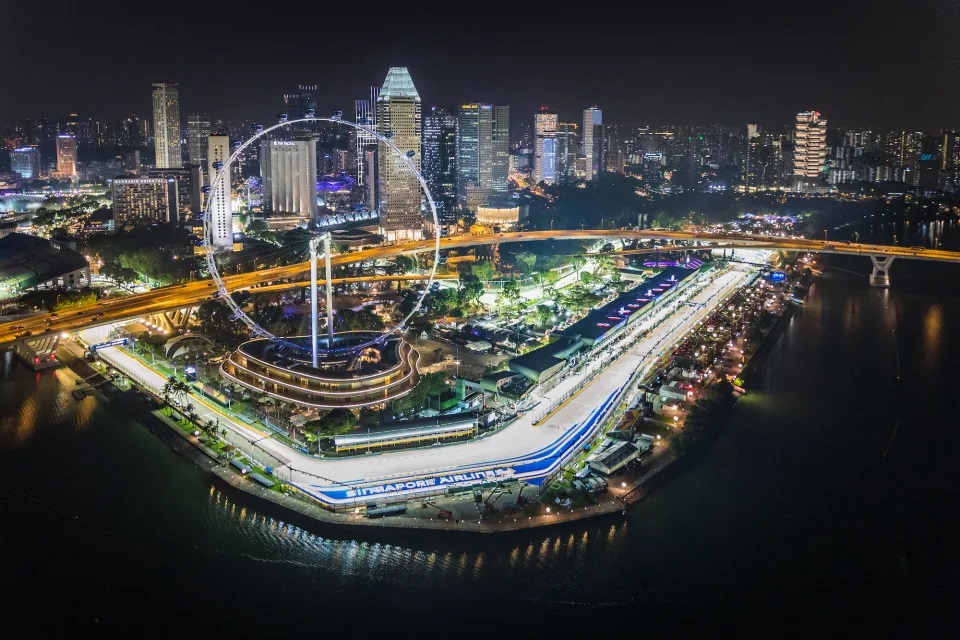
Teams and drivers consequently have to manage an unusual timetable, with the race start at 20:00 local, meaning breakfast in mid[1]afternoon, dinner in the early hours, and blackout curtains in hotel rooms essential. Singapore’s high temperatures and humidity levels also adds to the challenge for everyone in the team.
For 2023 there has been an alteration to the Marina Bay Street Circuit. Due to redevelopment work of The Float into NS Square, the old turns 16 to 19 will be bypassed, creating a longer full-throttle section between turn 14 and the old turn 20, which is now turn 16.
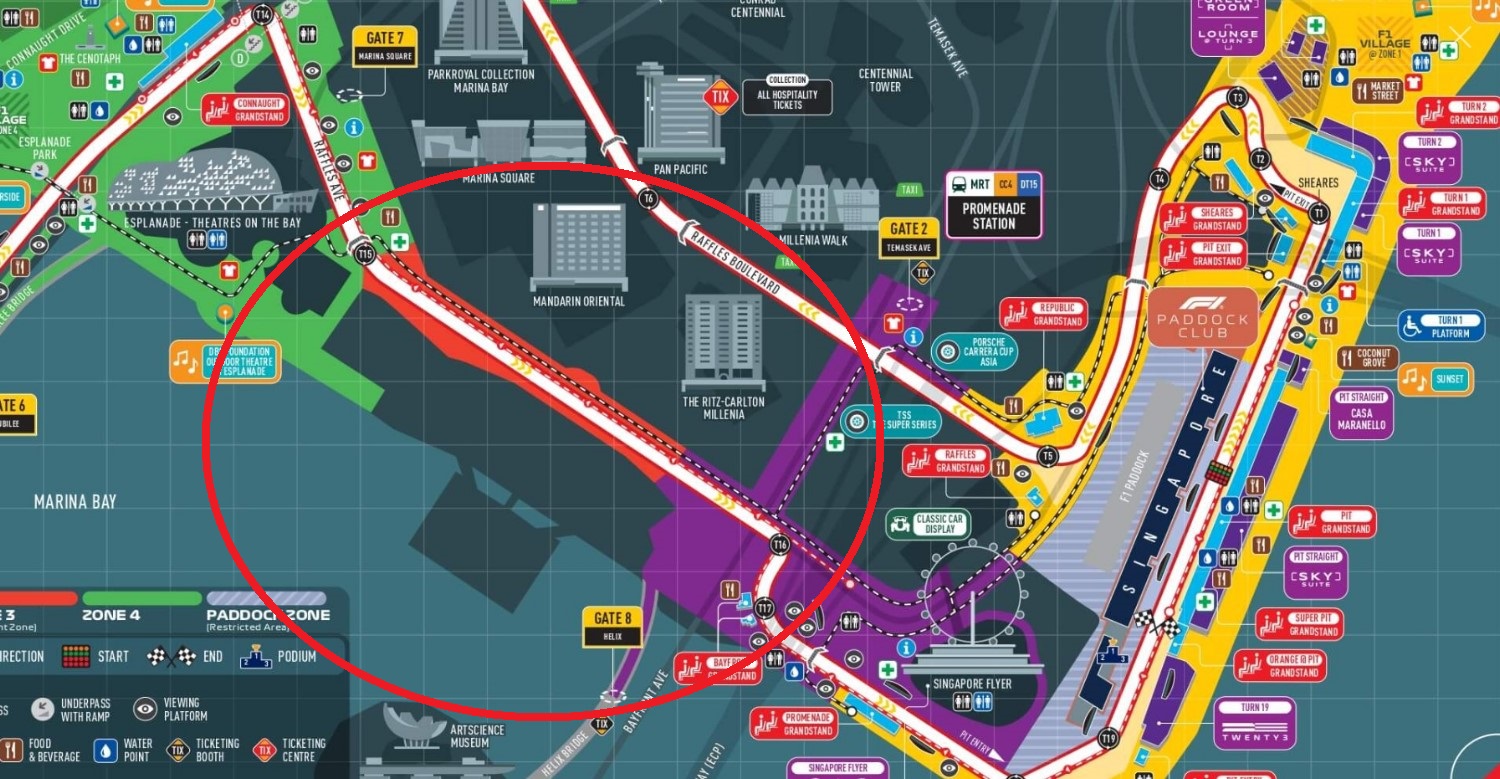
That has shaved 135 meters of distance from the lap, with the removal of the corners expected to lower lap time by almost 10 seconds, with turn 16 approached at greater speed.
The average lap speed is expected to be higher than previous years but Marina Bay remains among the circuits with the slowest lap speed, with Singapore’s grands prix regularly pushing towards the two-hour mark.
Singapore is a special race for the world of Formula One, too. It’s a peculiar one, a race in which to juggle European times on South-East Asian soil; a race of late wake-ups, even later bed times, heat and humidity. But far from being displeasing, these elements all make Singapore a race like no other: you haven’t really fully been in the sport unless you have a fun Singapore story to share
The bumpy circuit, located in the Marina Bay district, takes Formula 1 drivers past some of Singapore’s famous landmarks, including the National Gallery, the Esplanade Concert Hall, and Singapore Flyer. The floodlit architecture provides a stunning backdrop to one of Formula 1’s most challenging events.
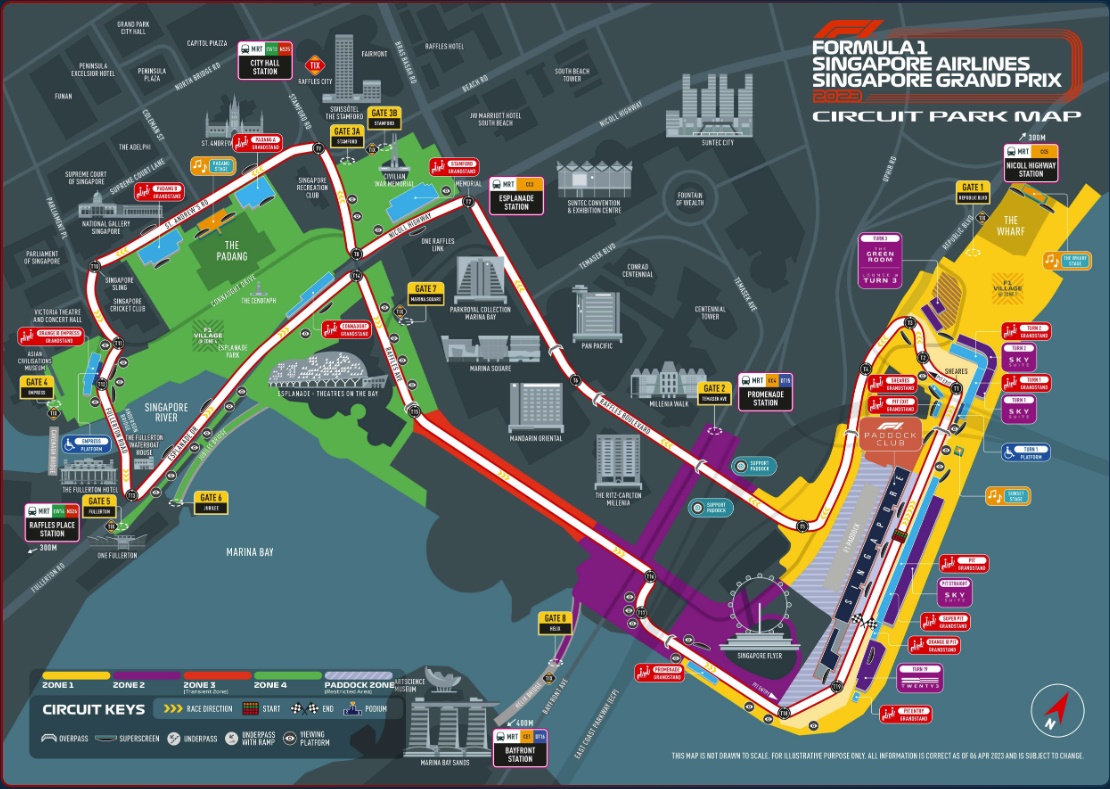
Weather Forecast
Friday
High/Low 93° /80° with a 40% chance of a shower
Hot with sunshine and some clouds; a thunderstorm around in the afternoon; caution advised if doing strenuous activities outside
Saturday
High/Low 90° /79° with a 42% chance of rain
Mostly cloudy with a thunderstorm in a couple of spots in the afternoon
Sunday
High/Low 89° /78° with a 44% chance of rain
A thunderstorm in a couple of spots; cloudy in the morning, then times of clouds and sun in the afternoon
Fact File: Singapore Grand Prix
- This year’s Singapore Grand Prix will feature a new layout as redevelopment works take place in the vicinity of the track.
- The circuit between what was Turns 16 to 19 will now become one long 397.9m straight, reducing the number of corners from 23 down to 19.
- The circuit length has therefore reduced from 5.063 km to 4.928 km and the number of laps of the Grand Prix increased from 61 to 62.
- Lap times are expected to be reduced by roughly 10 seconds due to the changes.
- The new layout will likely be beneficial for the tires; previously, they would begin to overheat towards the end of the lap, but the removal of four 90-degree corners should help them stay closer to the optimum operating window.
- Track evolution is incredibly high in Singapore, given that it is a street circuit. The surface can ramp up by as much as three seconds between FP1 on Friday and Qualifying on Saturday evening.
- The Singapore Grand Prix is one of the most physically demanding races of the season. The intense humidity, warm temperatures, combined with the stop/start nature of the track, make it very challenging.
- Due to these factors, drivers can lose around 3kg of weight during the race through sweating alone.
- That stop/start nature, with a requirement for constant re-acceleration, ensures the circuit has the biggest fuel effect of the year. In simple terms, that means the amount of time you lose each lap is higher for every kilogram of extra fuel in the car.
- Owing to the large amount of time spent in corners, just 50% of lap time is spent at full throttle.
- That is one of the lowest percentages of the season, with only Monaco, the Hungaroring, and the Autódromo Hermanos Rodríguez in Mexico with lower amounts.
- The Marina Bay Street Circuit has the largest number of heavy braking events of any circuit we visit at four.
- The lack of long straights and short distance between turns also puts less air through the brakes. Cooling is therefore a big focus for the team.
- The track is also very bumpy. That adds to the stress that the drivers and cars are put through – that is particularly true with these new generation cars that run lower to the ground.
- The circuit also impacts the tires as the surface temperatures can never properly cool down. The tarmac is also aggressive on the tires, increasing wear and degradation.
- With a speed limit of 60 km/h, and a layout that feeds in at turn two, the total pit lane time is the highest of the season at 25 seconds.
- Owing to the layout changes, the number of gear changes per lap has dropped to 64. It was previously the circuit with the highest amount of gear changes, but now ranks fourth overall.
- Given the nature of a street track, it is perhaps no surprise that all 13 of the previous Singapore Grands Prix have featured at least one Safety Car deployment.
- In the last five editions, we have seen 10 Safety Car deployments.
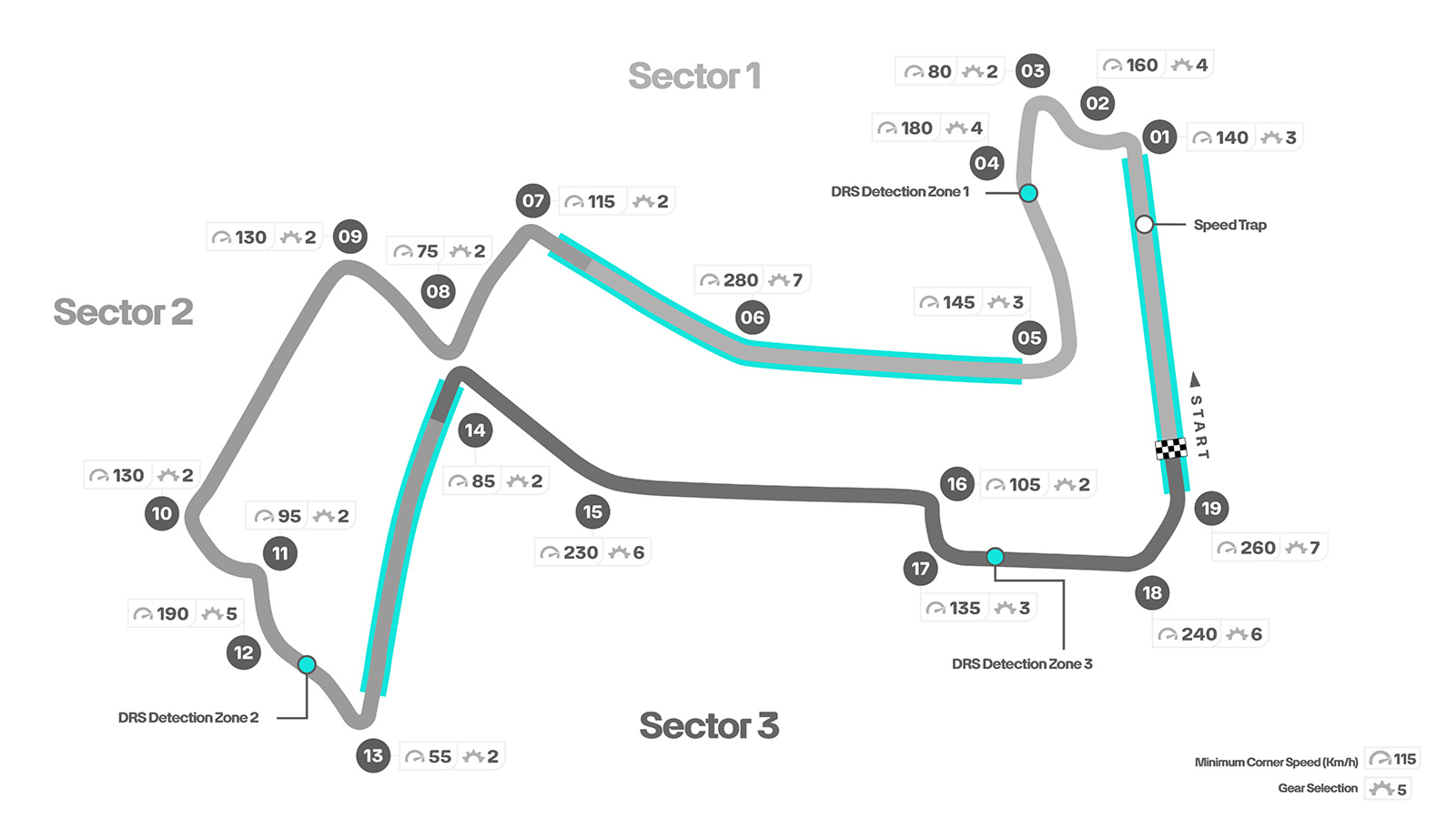
Heat and Humidity
Faith Atack-Martin – Performance Coach and Team Physiotherapist:
Singapore is one the most challenging races for drivers, but it’s also tough on the team in the garage. How do you prepare the team for the extreme heat and humidity faced there and ensure they remain physically and mentally fit?
“The heat in Singapore is significant, but heat acclimatization over the season in other hot conditions affords the crew some pre-preparation for this by the time we hit Singapore in September. However, the humidity poses an additional challenge and requires some careful management to ensure that the team members can regulate body temperature (thermoregulation), stay hydrated and perform at their best.
“Physical and mental conditioning in this environment consists of many considerations. Firstly, avoiding heat illness is our priority. This relies on maintaining equilibrium between salt and water balance in the body. In hot and humid conditions, the surrounding air is higher in water molecules, making it harder to regulate body temperature because heat cannot evaporate as efficiently. The body responds to this by increasing the rate it sweats, resulting in increased water and salt loss. If fluids and salt are not replaced, then isotonic dehydration occurs, leading to an increased risk of exertional heat illness or exertional heat stroke in severe cases.
“Other strategies aim to facilitate thermoregulation. Cooling strategies include access to iced towels, sweat bands and the use of an air-conditioned break-out room in the garage where team members can go to take a break. Another adjunct we use is menthol mouthwash. Although using this does not affect core temperature, the perception of heat can be manipulated. Similarly, using cold sprays gives a temporary feeling of coolness that can help in addition to more robust methods.”
How does Singapore test drivers’ stamina? Team Ambassador and veteran F1 driver Pedro de la Rosa reflects on his experience racing at the Marina Bay Circuit.
“Singapore has become the most demanding Grand Prix by far from a physical point of view – it’s comparable to the Malaysian Grand Prix. I was happy to see the Safety Car during the race; it was an opportunity to hydrate and take a breath. The heat and humidity are unrelenting, this is a long race that can hit the two-hour limit, and there’s a lot of stress. Marina Bay Street Circuit is a track that requires precision and concentration, and you can pay a big price for a small mistake.
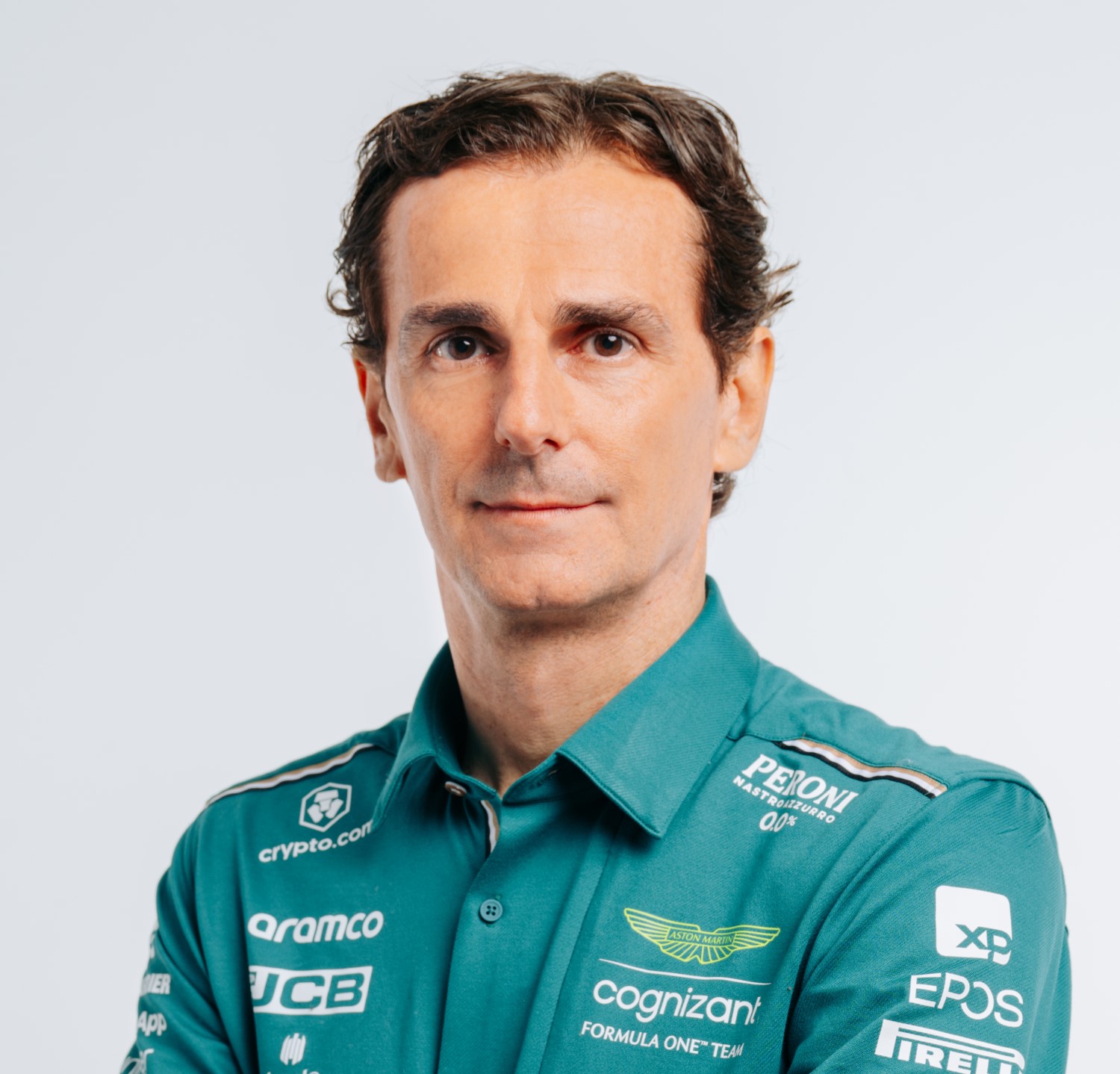
“One of the best ways to train for it is to run a lap of the circuit late at night – rather than training in an air-conditioned gym – to experience the climatic conditions. That’s why some drivers take an exercise bike into a sauna when they’re in Europe as part of their preparations for this Grand Prix. I feel like I could see better here than I could at some day races – the lighting is brilliant and there are no shadows, so I could see every detail of the track. I even experimented with using a tinted visor during practice sessions.
“The easiest thing about the Singapore Grand Prix is the schedule. You eat breakfast, lunch and dinner at the same time you would in Europe, so there’s no jetlag. It’s important to ensure that in the hotel, there’s no daylight coming in when you’re trying to sleep during the day – and tell the hotel not to disturb you. That can upset your rest and your race.”
What to watch for
Race interruptions: There were six DNFs here in 2022 – higher than average due to wet weather – but even in the dry, interruptions are common at Marina Bay. Every race here since 2011 has had at least one Safety Car with many having had multiple. In 2022, there were three Virtual Safety Car deployments.
Overtaking: This is one of the hardest venues at which to overtake, second only to Monaco. With an alternative layout this year, with Turns 16-19 removed and replaced by a straight, there might be an increased number of overtakes in the Grand Prix. Historically, the first DRS zone has been the prime passing place.
Strategy: A one-stop strategy is expected to be the fastest one at Marina Bay, given the pit loss of 27 seconds – the highest of any circuit on the calendar thanks to the 60km/h speed limit and tricky pit entry. Pirelli is bringing the softest trio of compounds to Singapore for maximum grip on a twisty and demanding track.
Unlocking the Lap
The lap begins with a short run to the opening three turns. Turn One is a medium-speed left-hander that exits onto a shallow right-hand bend and immediately leads to a sharp left-hander. A long straight follows to Turn Five, where it’s important to use all of the entry curb to maximize your exit and carry as much speed as you can down Raffles Boulevard, the first of three DRS zones.

Turn Seven is a hard braking zone followed by 90-degree corners in Turns Eight and Nine. Turn 10 is the Singapore Sling, a medium-speed left-hander that leads into a pair of fast corners that exit onto Fullerton Road, a short straight that bends to the right – making the entry into the Turn 13 hairpin tricky.
The second DRS zone follows Turn 13, leading onto the sharp Turn 14 right-hander. The following straight – with a left-hand kink – could prove conducive to overtaking, with the Turns 16-17 chicane ending that high-speed run. The lap finishes with two high-speed left-hand corners, Turns 18 and 19, and the start-finish straight with another DRS zone.
Three DRS Zones Remain
In the last 12 Singapore Grand Prix’s just an average number of 25 overtake moves have occurred.
The increase in DRS zones in 2019 led to the largest number of position changes happening, with 59 overtakes in the race won by Sebastian Vettel.
This in contrast to 2009 when there were just three overtakes in the race that was eventually won by Lewis Hamilton.
All eyes on Verstappen
“Marina Bay is a cool circuit. This year it will be interesting to see how the revised track layout will impact the general behavior and set up of the car, I think the lap times will be much quicker.
“Singapore is probably going to be the most challenging weekend out of the upcoming races as the stakes are heightened on a street circuit and the field is usually very close, not to mention the heat and humidity.
“Last year we had a very unlucky weekend, hopefully this year it will go a bit better and we’ll of course do our best to make sure we score maximum points this weekend.”
Sergio Perez wants to win again
“I am looking forward to going back to Singapore, last season was probably one of the best races of my career. It was such a hard one to navigate, with the heat, the track conditions and the concentration that is required around a street circuit.
“Of course, I would love to repeat the win but it will be tricky, the new track layout is going to make things quicker in sector three and there will be rain, so it could be fun!
“This weekend is my 250th race in Formula One and I never would have imagined I would race an F1 car that many times when I started my career. It has been a dream and I am proud to have represented Mexico all over the world for this many years and I would love to give them another win this Sunday.
“I have a one-off helmet to mark the moment and I think it’s going to look very special under the lights at night.”
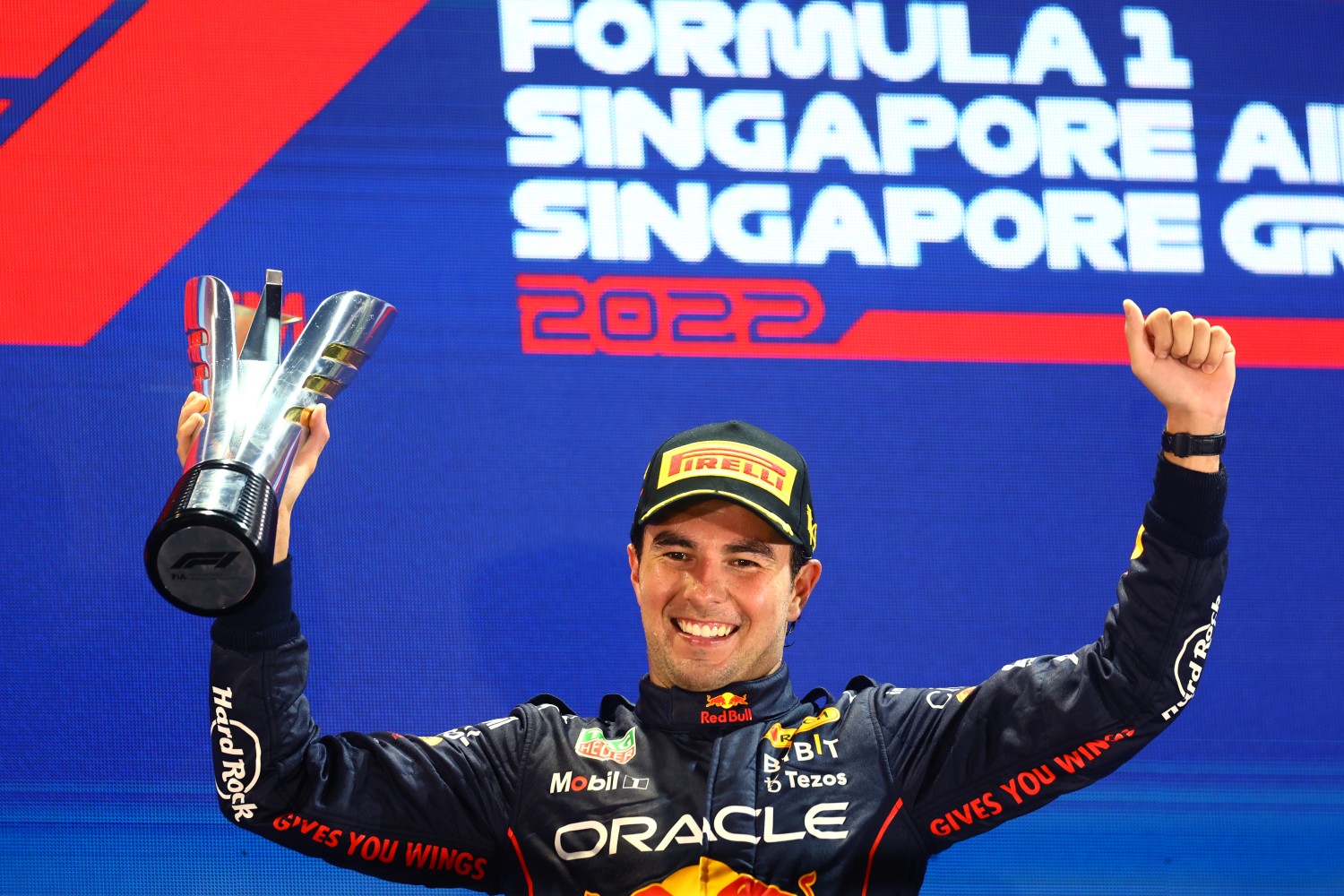
Driver Perspective – Alex Albon Williams F1 Team:
It’s an exciting race weekend as it’s kind of a home race for me and a special one for the team; we showcase our winning fan voted Gulf livery for the first race here in Singapore which is going to look amazing under the lights. We return to a street track which is very bumpy and quite uncompromising, with the heat making it one of the most difficult and demanding events of the year. There’s been a lot of prep work going into this week, working our best to acclimatize before the weekend starts. Whilst this isn’t a track that would ordinarily suit our car, it will be interesting to see how it does over the weekend, with the weather also likely to make things more challenging.
Logan Sargeant Williams F1 Team
I’m really excited to be driving under the lights at Marina Bay for the first time. It’s a track I’ve wanted to race at since I was a kid. It will be a physical race but I’m ready for the challenge. Singapore will also be a special occasion for the team as we race with the fan voted Gulf livery for the first of three races, so we’re hoping to make it a good one.
Pirelli Tires
Pirelli are providing their softest compounds for this event, which is a combination teams last used in Canada. The layout of the circuit means that traction is the biggest demand placed on the tires, and how well each compound deals with this will depend heavily on the track conditions on the day. Teams will need to assess all three compounds on Friday before deciding on the likely race strategy.
MARIO ISOLA – MOTORSPORT DIRECTOR
“The closing stages of this long season, taking Formula 1 to three continents and 16 different time zones, kicks off in Singapore this weekend. This was the first race to take place under artificial light: an idea that was later followed, in varying degrees, by other venues. From a technical point of view, Marina Bay is a typical street circuit: very twisty (with 19 corners, many of them 90-degree) and little run off. As a result, even a small mistake can be costly, while the track layout also means that the cars run a high level of downforce. This year, the lap takes on a new look due to some building work in the Marina Bay area: the part of the track that was previously turns 16 to 19 is now just a single straight, which is nearly 400 meters long. This change will make the track faster; firstly because the total lap length is now less than five kilometers and secondly because the layout has become a lot more flowing. We’ll wait to see if this change has an effect on strategies, because in theory at least it could create an overtaking opportunity – with passing notoriously difficult unless you have a much faster car.
This track doesn’t place particular stress on the tires in terms of loading, but the rear tires need to be carefully managed during the traction phase when exiting slow corners. Temperatures are usually consistently high, as Singapore is only about 150 kilometers from the equator. This increases the risk of overheating: not just for tires but also everything else, including the mechanicals and of course the driver!”
THE TIRES ON TRACK
- As has been the case for all the other street circuits this year, Pirelli will bring the trio of softest compounds to Singapore: C3 as P Zero White hard, C4 as P Zero Yellow medium and C5 as P Zero Red soft.
- The Singapore Grand Prix takes place at night, starting at 8pm local time. The intense humidity, high temperatures and heat retention due to the walls lining the track make this a physically demanding race for the drivers.
- The layout has been modified this year, with the section of track between turns 16 and 19 now becoming a straight that is around 397 metres long. This means that the number of corners goes down from 23 to 19, while the total lap length is now 4.940 kilometres (compared to 5.063 previously). The race has been extended to 62 laps: one lap more than last year.
- There’s plenty of ‘street furniture’ on the public roads that make up the Marina Bay circuit such as painted white lines and manholes, which can affect grip levels: especially if it rains.
- A one-stop strategy is the clear way to go, also because the pit stop loss time of around 28 seconds is the highest of the season, together with Imola. The hardest compound available is normally the main race tire if it stays dry.
- As with other street tracks, grid position is usually crucial to a good finish, given the limited overtaking opportunities. Qualifying tends to have a strong influence on the final outcome.
- Last year, the race start was postponed by an hour due to a storm that hit Marina Bay a few minutes before grid formed up. The cars began the race on intermediate tires and then switched to Medium and Soft – with a Virtual Safety Car also influencing strategy.
- The first edition of the Singapore Grand Prix was held in 2008. Since then it has been held a further 12 times at the Marina Bay track, with no race held in 2020 and 2021 due to the Covid-19 pandemic. There have been five different winners in total: Sebastian Vettel (five victories), Lewis Hamilton (four victories), Fernando Alonso (two victories), and Nico Rosberg and Sergio Perez, who have each won once. The teams with the most victories are Mercedes and Red Bull, with four wins each, while Ferrari has set the most pole positions: six.

